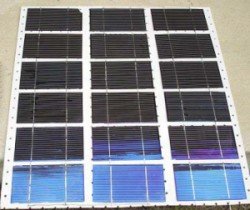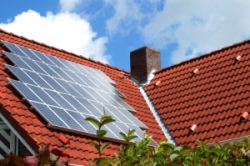Solar Water Heating
Heat your household water with the power of the Sun!
Solar water heating uses solar thermal energy to heat your household water.
If your household is like most, about 15-30 percent of your energy use goes to making sure you have hot water. That's significant, but there's help...
Installing a solar water heating system can save you thousands of dollars over the life of the system, which could be 40 years! On top of that, the value of your home will increase the moment your system is installed.
So if you are looking for an energy efficient water heater, you should definitely consider your solar energy options.
All solar energy water heating systems perform the same basic functions...
- Gather heat in a solar collector
- Transfer the heat to the water supply
- Store the heated water until ready to use
There are two types of solar energy water heating systems to handle these basic functions, passive solar energy systems and active solar energy systems.
Passive Solar Water Heating
Passive solar energy heating systems do not use any electric components or pumps to circulate the water through the system.
Two types of passive solar energy water heater systems are thermosiphon systems and batch heaters.
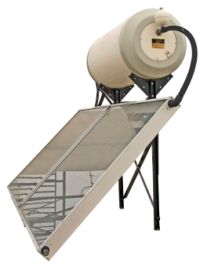 Thermosiphon
ThermosiphonA thermosiphon system has the storage tank located above the solar collectors. This allows it to take advantage of a principle known as natural convection.
Natural convection is based on the fact that warm water rises and cold water sinks. This phenomenon occurs due to the difference in the density of the warm water and the cold water. The cold water has a higher density, or is heavier, so it sinks.
Natural convection creates a flow of water through the system. As the cold water sinks to the bottom of the storage tank, it flows back to the solar collectors to be warmed up. Once warmed up, it naturally rises, flowing back to the storage tank to be used by the household or recirculated to the solar collector if it cools down before being used.
A batch heater is simply a water storage tank, usually painted black, that is placed inside of an insulated collector box that has a glazed glass cover to allow sunlight to hit the water tank. The water pressure in the home's plumbing controls the flow of the water to the faucets. Because the storage tank is inside the solar collector, these systems are also known as integrated-collector-storage (ICS) systems.
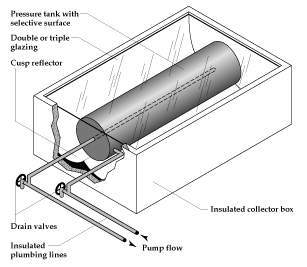 Batch Heater
Batch HeaterPhoto: Courtesy DOE/EERE
Active Solar Water Heating
Active solar water heating systems use pumps to circulate the water or heat-transfer fluid through the system. There are two types of active solar energy water heater systems, closed-loop and open-loop systems.
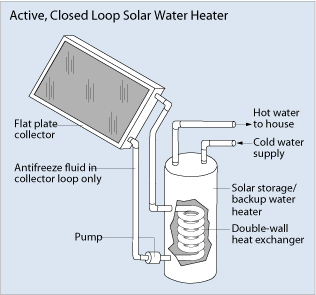 Closed-Loop Solar Water System
Closed-Loop Solar Water SystemPhoto: Courtesy DOE/EERE
In a closed-loop system, a heat transfer fluid is used. The heat transfer fluid is usually a water-antifreeze mixture. After the fluid is heated in the solar collectors, it is pumped to a storage tank where a heat-exchanger transfers the heat from the fluid to the household water.
A closed-loop system is also known as an "indirect" system since the household water is heated by the heat transfer fluid and not directly in the solar collector. This system is suitable for areas that experience freezing conditions.
In an open-loop system, household water is heated in the solar collector and pumped to a storage tank. The heated water is then piped to faucets for use by the household.
An open-loop system is also known as a "direct" system since the household water is heated directly in the solar collectors. Since this system uses regular household water directly in the collector, it should only be used in areas that do not experience freezing conditions.
A Great Solar Investment
Installing a solar water heating system for your home will cost you several thousand dollars. But with the increase in your homes value and reduced utility bills, the system will more than pay for itself within a few years.
You also won't find a more energy efficient water heater system than solar energy. When you add in the positive impact this will have on our environment, it's clear that this is a great investment for homeowners!
Home > Solar Heating > Solar Water Heating
